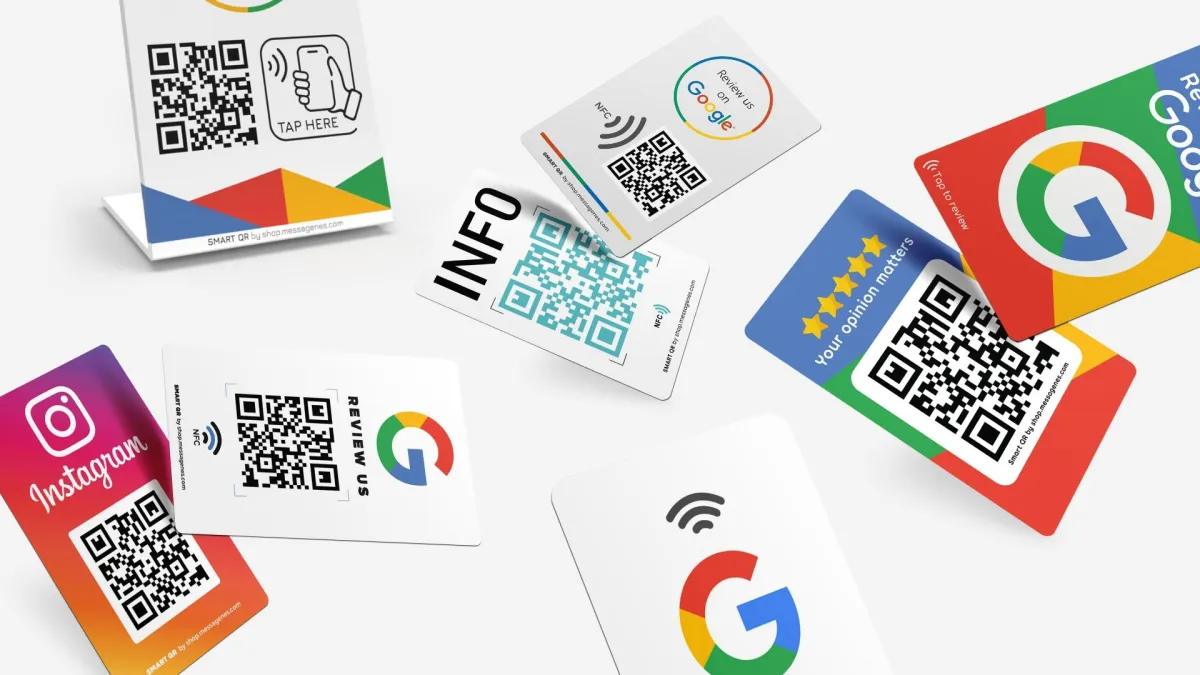
Do Google Review Cards Work?
Do Google Review Cards Work? A Practical Guide to Choosing the Best Option for Your Business
Introduction: The Power of 5-Star Reviews
In the digital age, reviews have become one of the most valuable assets for any local business. They not only influence how potential customers perceive your brand, but also directly impact your company’s visibility in Google search results. Five-star reviews work as social proof: they build trust and credibility—key elements for attracting new customers. Additionally, a higher number of positive reviews can boost your local SEO ranking, helping your business appear above competitors. It’s common to see new entrepreneurs on forums like Reddit asking:
“How can I get more reviews to stand out on Google?”
Questions like these have led to the rise of practical tools such as review cards, which are designed to make that process easier and more effective.
What Are Review Cards with QR or NFC?
Review cards with QR or NFC technology are physical tools designed to help customers leave a review on a business’s Google profile. They work very simply: by scanning a QR code with a smartphone camera or tapping the device on an NFC chip embedded in the card, the customer is taken directly to the business’s Google review section.
These cards can be handed out at strategic moments, such as after a purchase, with the check at a restaurant, at trade shows or events, or even as part of a promotional package. Their goal is to reduce the friction between a satisfied customer and the act of leaving a review, making the process as smooth as possible. They come in various designs—from elegant plastic prints to simple stickers or cardboard cards with clear instructions.
Do They Actually Help You Get More Reviews?
Yes, review cards can be highly effective if used properly as part of a well-thought-out strategy. Their biggest advantage is immediacy: instead of asking the customer to manually search for your business on Google, you provide direct access with a simple scan or tap. This significantly increases the likelihood that the action will be completed. They’re also affordable, reusable, and don’t require technical knowledge to implement.
However, their success largely depends on the context in which they’re presented: the moment must be right, the message natural, and the customer experience must have been positive. It’s essential to remember that these cards don’t replace good customer service—they enhance it. A customer who had a great experience will be much more inclined to leave a review if the path is easy.
QR and NFC Cards: A Combined Solution
Nowadays, many cards designed to facilitate Google reviews include both QR and NFC technology. This combination offers the best of both worlds:
QR Code: Scannable with any smartphone camera, perfect for all users.
NFC Chip: Just tap the phone to open the link automatically (on compatible devices), offering a smoother experience.
These hybrid cards are extremely effective because they remove nearly all technological barriers for users. If their phone doesn’t support NFC, they can scan the QR. If they prefer not to scan codes, they can tap their phone. This increases the likelihood of receiving a review. These cards are also typically made from durable materials like plastic or PVC, making them perfect for continued use on counters, tables, or during events.
Which One to Choose? Key Recommendations
Choosing the ideal type of card depends on several business-specific factors:
Customer type: If your audience is young and tech-savvy, NFC cards will be well received. For more traditional audiences, QR codes or direct links may be more appropriate.
Business setting: In high-traffic places like coffee shops or food trucks, stickers on tables or counters work better than individual cards. Conversely, in more personal settings like clinics or boutique stores, handing over a physical card can add a personalized touch.
The key is to align the card with the customer’s overall experience. A card that feels natural and well integrated into the service flow builds trust and earns more reviews.
Tips for Using Them Effectively
Having the cards isn’t enough—you also need to know how to use them strategically to maximize their impact:
Strategic placement: Put them in visible, accessible places—on tables, near the checkout, inside shopping bags, or next to the bill. The goal is for the customer to see it just when they’re happy with the service.
Right message: Instead of asking for a “5-star review,” focus on an authentic and appreciative message. For example: “Did you enjoy our service? Your feedback helps us improve.”
Human touch: If you hand it over personally, do it with a smile and a brief explanation. For instance: “If you have a minute, we’d love to hear your thoughts. Just scan this code.”
Don’t offer monetary incentives: Offering discounts or gifts in exchange for reviews violates Google’s policies. Instead, show genuine gratitude or publicly share the feedback to encourage others.
Common Mistakes When Using These Cards
While QR and NFC cards are powerful and easy to implement, using them incorrectly can sabotage your results. Here are the most common mistakes businesses make and how to avoid them:
❌ 1. Asking directly for “5-star reviews”
This is one of the most common and serious mistakes. Asking explicitly for a “5-star review” may seem like a direct strategy, but it violates Google’s policies. This practice can result in those reviews being deleted and could negatively affect your business’s visibility in search results.
✅ Better approach: Ask for honest feedback and express appreciation. A message like “Did you enjoy our service? Share your experience with us” is much more natural and effective.
❌ 2. Using broken or misconfigured links
Sometimes, businesses set up their cards without checking that the link redirects correctly to the Google, Instagram, or Facebook review section. Or they use a generic link that doesn’t take users directly to the “Write a review” screen—adding unnecessary steps and lowering conversion rates.
✅ Better approach: Make sure both the QR link and NFC chip are correctly configured. Test them on different devices before distribution, and if possible, use a link shortener with UTM parameters to track performance.
❌ 3. Not providing context when handing out the card
Cards are often given out without any explanation. This reduces effectiveness because customers may not understand their purpose or feel motivated to scan them.
✅ Better approach: Train your staff to give a short explanation along with the card: “This card lets you leave us a review in just two clicks. We’d really appreciate it!”
❌ 4. Not integrating the cards into a coherent experience
The card shouldn’t feel like a random element. If the service or product was unsatisfactory, no card will work. Likewise, if the card’s design doesn’t match your brand’s identity, it may send a conflicting message.
✅ Better approach: Make sure the card’s design, language, and timing align with the customer experience. It should feel like a natural extension of your customer service.
❌ 5. Not measuring or adjusting the strategy
Rolling out cards and then forgetting to follow up is another common mistake. Without analysis, you can’t know if they’re working, how many reviews you’re getting, or how to improve the strategy.
✅ Better approach: Use trackable links, ask customers if they scanned the card, and evaluate how your reviews change in the months after implementation. This lets you refine your approach and maximize your return on investment.
Avoiding these mistakes can mean the difference between a card forgotten in someone’s wallet and an effective tool that boosts your digital reputation. Remember: even a good tool needs to be used correctly to deliver results.
Types of Cards Available
✨ Google Review Cards: These cards take customers directly to your Google Business profile, making it fast and easy to leave a review. They’re ideal for increasing visibility and online reputation on the most widely used review platform.
✨ Social Media Cards: These cards are designed to drive traffic to your social media profiles—like Instagram, Facebook, or any other relevant platform. By scanning the code or tapping the NFC chip, customers can interact with your content, follow your profile, and engage with your brand. They’re excellent for boosting social reach and building an online community.
✨ Info Cards: These cards allow businesses to share direct links to their website, catalog, business hours, or any other relevant info. Scanning or tapping opens a personalized destination, making them a versatile and effective communication tool.
✨ Customizable Cards: These cards allow businesses to personalize both the design and the links included—creating a unique experience for customers. You can link to your website, special offers, or any other info you want to share. Their flexibility makes them a perfect choice for reinforcing brand identity and providing a more personal customer interaction.
These cards are available as standard cards or stickers, all with combined QR + NFC technology.
Conclusion: Beyond the Card
Business cards remain a useful tool—but in today’s world, they go far beyond a physical contact point. Cards are now gateways to your business’s digital identity, offering direct links to online reviews and social media profiles. By including QR codes or personalized links, customers can learn more about your company, engage with it online, and leave reviews—strengthening your online presence and reputation.
However, more than just giving access to these channels, what really makes the difference is how you manage those interactions. Great service, consistent customer care, and effective communication are the pillars of customer loyalty. Online reviews, when properly managed, are a powerful tool to reinforce that relationship.
That’s why having an efficient review management system—like the cards we’ve described in this post—can amplify your business impact. They not only make the initial connection easier but also help consolidate your online reputation, showing your commitment to quality and customer satisfaction. In this way, review cards become an extension of your customer service and a bridge to deeper, longer-lasting relationships.
Interested in how these cards can help grow your small business? Check out this post about smart business cards—you’ll be surprised!



